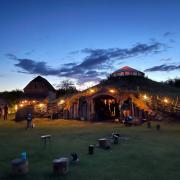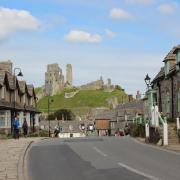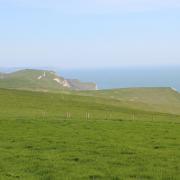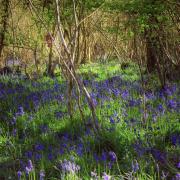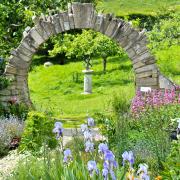Dark Skies champion, Bob Mizon MBE of the Wessex Astronomical Society, shares his astronomical highlights for the year ahead
For good stargazing opportunities, you need clear still nights and dark skies. Fortunately, in Dorset we have many accessible dark sites ideal for stargazing especially in the Dorset Area of Outstanding Natural Beauty (AONB), in rural areas to the west of the county, and in the Dorset part of the Cranborne Chase AONB, itself declared an International Dark Sky Reserve in 2019.

5 Dorset stargazing hotspots [run as a block with the stargazing durlston and talks }
It’s always worth doing a reconnoitre in daylight so you are familiar with where to park, your route from the car to a suitable stargazing spot (not on private land), and spotting any potential hazards enroute such ditches, fences, mud etc.
On the night, take a torch (with spare batteries) and a fully-charged mobile phone, wear layers of warm clothing, hat, gloves and suitable footwear, take a hot drink and snack, and have something waterproof to sit on. Ideally don’t go stargazing alone, and let someone know where you are going (your mobile may not have a signal), and when you expect to be back. Try safe parking spots at or near the following sites:
In Dorset AONB: Hardy Monument/Black Down, DT2 9HY north of Weymouth; Ansty/ Bulbarrow Viewpoint, DT11 0HQ north of Milton Abbas
In West Dorset: Lambert’s Castle Hill (a hill fort, not a castle!) DT6 5QL
In Cranborne Chase AONB: Knowlton Church and Earthworks, BH21 5AE; Badbury Rings (away from car lights of nearby B3082), DT11 9JL
For astronomy events at Cranborne Chase AONB visit chasingstars.org.uk

Stargazing at Durlston: Join experts from the Wessex Astronomical Society to use telescopes at their observatory next to the Learning Centre at Durlston Country Park near Swanage, to view the Moon, planets, galaxies and constellations. Weather dependent - phone on day to confirm if cloudy or rainy. Dates coming up: January 28, February 12, March 10 & 25 starts at 7.30pm. Cost £3. durlston.co.uk/events
Astronomy Talks: Wessex Astronomical Society hold monthly astronomy talks at the Allendale Centre, Wimborne (wessex-astro.org.uk), Weymouth Astronomy Club's talks are at St Aldhelm’s Church Centre, Spa Road (weymouthastronomy.co.uk).

Starry Highlights for 2023 [new section}
Meteors: Also known as shooting stars, meteor events – one hesitates to call them ‘showers’ as they don’t normally fall like rain – occur on the same date every year as the Earth passes through ancient cometary debris that burns up in the atmosphere. Meteors can produce not just visible flashes, but also sparkly wakes and gaseous trails that might last for a short while in the upper atmosphere, these can be seen through binoculars. The most reliable meteor events are the Lyrids (mid-April, rising from the north-east), the Perseids (around August 11-13, in the north-east), the Leonids (their radiant point moving from north-east to east around November 17) and the Geminids (mid-December, the radiant high in the south-east).
Lunar Eclipse: On October 28 a small partial lunar eclipse may be seen throughout Europe, Asia, Africa, and Western Australia. In Dorset it can be viewed around 8 to 9pm, as the dark shadow of the Earth grazes the lower part of the lunar disc. Binoculars will help you to see this moment if the skies are clear.

Admiring the Milky Way: The greatest wonder of the night sky is without doubt the silvery arch of the Milky Way, best seen from a dark place, high above in the late evening in summer and on into autumn and winter. Many urban dwellers have never seen this awe-inspiring sight. Sweep your binoculars across this Galaxy of possibly half a trillion stars in which we live, our Sun is a comparatively minor star orbiting its Galactic Centre every 250 million years. The Milky Way’s pearly starfields are riven by skeins of dark clouds, ashes of long-dead generations of stars which have created, in the multi-million-degree forges of their cores, the chemical elements of which everything, including ourselves, is made.


Seasonal Stars: Various prominent stars of different hues shine out as the beacons of the night sky throughout the year. Spring offers such gems as Capella, the yellowish ‘Goat Star’, in the constellation of Auriga the Charioteer (an orbiting pair of stars 43 light years away). Summer sky watchers see a much hotter star, steely blue Vega (26 light years), high above and part of the Summer Triangle (Vega, Deneb and Altair) of bright stars that straddles the Milky Way stream. In Autumn blue-white Altair (16 light years) is at the southern tip of the Triangle, pointing down towards the ‘watery’ constellations of Aquarius the Water-Carrier and Capricornus the Sea-Goat. The brightest gem of Winter, indeed of all the night’s stars, is Sirius (8 light years), glittering in various hues as atmospheric refraction causes its light to dance.

Five planets to watch this year [new section}
Mercury: Elusive but always close to the Sun, Mercury is best seen around January 22 when it rises low down at dawn before the Sun in the south-east (never look with optical aid if Sun is risen).
Venus: A surprisingly bright object in the dawn or evening sky in the same direction as sunrise or sunset, the end of April and beginning of June will be a good time to spot Venus in the west in the evening.
Mars: Watch this ruddy planet moving slowly from Taurus into Gemini in the winter sky in the first quarter of 2023.
Jupiter: This giant planet dominates the south-western evening sky in January and February, then disappears into the Sun’s glow, re-emerging into the dawn sky from mid-June.
Saturn: Look for this pale-yellow planet low in the south-west in the evening at the start of the year, it then adorns the south-eastern dawn sky from mid-June.
Free online charts such as skymaps.com show the progress of planets, or read my monthly astronomy column for where and when to see stars and planets in Dorset’s dark skies.






